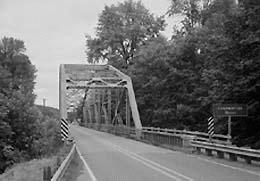In August 1923, the Dosewallips River Bridge opens, extending Highway 101 over the Dosewallips River. The river runs on the Olympic Peninsula through Jefferson County into Hood Canal, not far from Brinnon. This steel truss bridge is historically significant in engineering history because it is the earliest example of the standard-dimension truss design (making possible mass production of parts for more than one bridge) devised by the Washington State Department of Highways in 1921-1922.
The steel truss Dosewallips River Bridge can be described as follows: It is a riveted Pettit through-truss with sub-struts and a polygonal top chord (Pennsylvania). A through-truss is one in which the steel framework (the truss) is cross-braced above and below the traffic. The polygonal (many angled) top chord (the top horizontal part of the truss) is called Pennsylvania because the Pennsylvania Railroad used it very commonly for railroad bridges. The Pettit truss is a particular configuration of the supporting steel struts that make up the truss. It is a triangular configuration with smaller triangles supporting the top chord.
The project was contracted to the engineering firm Ward and Ward for $50,000. The bridge consists of a 240-foot truss span and two 32-foot concrete approach spans. It has a 20-foot roadway and a concrete floor. This was the first project in which the highway department put into practice the use of standardized dimensions for bridges (wherever feasible) as an economizing measure.
Bridges were once built the way houses were once built, one at a time and each with its own design. This new method in which small bridges would all have the same dimensions (just as prefabricated houses have the same dimensions) meant that truss parts and other parts could be manufactured in the same sizes for two or more bridges, a great economy.

